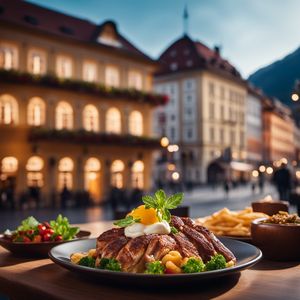
Dish
Lekvár
Lekvár is typically made from plums, apricots, or cherries, but can also be made from other fruits such as apples or pears. The fruit is cooked down with sugar until it reaches a thick, spreadable consistency. Lekvár is often used as a filling for pastries or spread on bread. It is a popular condiment in Hungary and other Eastern European countries.
Origins and history
Lekvár has been a staple in Hungarian cuisine for centuries. It was originally made as a way to preserve fruit for the winter months. Today, it is still a popular condiment and ingredient in many Hungarian dishes.
Dietary considerations
Lekvár is high in sugar and should be consumed in moderation. It is not suitable for those with diabetes or other conditions that require a low-sugar diet.
Variations
There are many variations of lekvár, depending on the type of fruit used and the cooking method. Some recipes call for the addition of spices such as cinnamon or cloves.
Presentation and garnishing
Lekvár can be presented in a jar or served in a small dish. It is often garnished with a sprig of mint or a dusting of powdered sugar.
Tips & Tricks
To make lekvár, use ripe, fresh fruit and cook it slowly over low heat to prevent scorching. Stir frequently to prevent sticking to the bottom of the pot.
Side-dishes
Lekvár is often served with pastries such as strudel or kolaches. It can also be spread on bread or toast.
Drink pairings
Lekvár pairs well with coffee or tea.
Delicious Lekvár recipes
More dishes from this category... Browse all »

Apple Butter
American cuisine

Birnenhonig
German cuisine

Cervelle de canut
French cuisine

Chapda Chutney
Indian cuisine

Chintextle
Mexican cuisine

Crema del Gerrei
Italian cuisine

Cretons
Canadian cuisine

Culadur
Corsican cuisine
More cuisines from this region...

Austrian cuisine
Hearty, Rich, Flavorful, Sweet

Czech cuisine
Hearty, Savory, Sweet, Tangy

Liechtensteiner cuisine
Hearty, Savory, Tangy, Sweet

Polish cuisine
Savory, Hearty, Rich, Earthy, Tangy

Slovak cuisine
Savory, Hearty, Rich, Earthy, Tangy

Slovenian cuisine
Savory, Hearty, Rich, Earthy, Tangy

Swiss cuisine
Savory, Rich, Creamy, Nutty, Sweet

